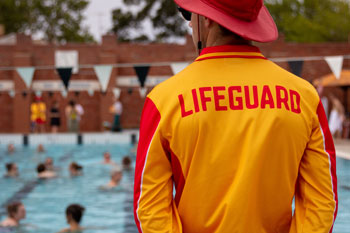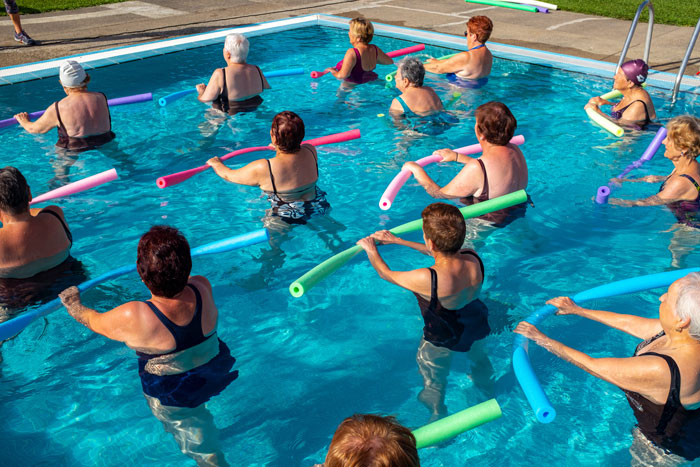A few months ago, I received a texted photo from a co-worker of a small, indoor health club pool with about 45 people in the water. They were engaged in an aquatics exercise class, and the pool looked crowded. His text said, “Funny thing is the sign on the back wall says ‘Capacity 145!’ No way this small pool can hold 145 people. Headline, ‘Kids aren’t the only ones who pee in the pool!’”
Now, being a pool professional, I see this photo and shiver. I’m sure, since you’re reading this article in a magazine partially dedicated to aquatic venues, you’re probably on the same page as me. Besides swimmers, we can only imagine what’s in that water. Yet most people probably don’t even think twice about hopping into a crowded pool. The chlorine in there kills everything, right?
Well, that’s what most swimmers think. They put their trust into the hands of the keepers and managers of these aquatic facilities. They might not notice if the water is cloudy or if the lifeguards can’t keep an eye on everyone in the pool at one time. Swimmers certainly won’t know if the water has enough chlorine in it to keep them safe. And these things can be real dangers.
Overcrowded commercial-size pools have many hazards, the most obvious being that too many people are in the water at once. This is an easy way for people to become injured, especially children. Bodies jostling into one another mixed with children jumping off the sides of the pool could very easily equal injuries, or even drowning.
Lifeguards do their best to watch everywhere at once, but in an overcrowded pool, it’s much easier for them to miss someone in distress. There are plenty of cases where children have drowned in a pool surrounded by adults with lifeguards watching. Drowning is not chaotic like we see in the movies. It’s typically silent, with no splashing, and happens quickly. Drowning of some children have occurred because cloudy water obscured a lifeguard’s view, which makes water clarity extremely important.
Keeping the pool’s water balanced and properly filtered is imperative for the safety of each and every swimmer. Balanced and appropriately filtered water is clear, and the bottom of the pool is easily visible. Keeping the pH between 7.2 and 7.8 and the total alkalinity between 80 and 120 ppm will help ensure clear water. Having the proper turnover rate for the volume of pool being filtered, along with pumps designed to handle that volume, will also help ensure good water quality.
According to the 2018 Model Aquatic Health Code (MAHC), the type of pool will determine its turnover rate. The MAHC dictates that wave pools or activity pools require a turnover rate maximum of 2 hours, while a diving pool requires a maximum of 8 hours. Keeping to these rules of water balance and proper filtering/turnover rates will help you keep a safe, clear and healthy pool. It also helps support sanitizer effectiveness. (i.e., chlorine levels between 1 and 4 ppm).

Drowning and injuries are not the only dangers seen in overcrowded pools. With all those extra bodies in the water, the sanitation chemicals are constantly under duress. Chlorine-based sanitizers, while effective at killing germs and breaking down the gunk, like sunscreen, that comes from swimmers, are not regenerative. If chlorine is used up, then the water becomes a breeding ground for any number of bacteria, viruses and parasites. Between 2015 and 2019, the CDC confirmed 155 pathogenic outbreaks in the United States caused by improper sanitizer levels. Thirteen deaths were confirmed from these recreational water illness (RWI) outbreaks. Having the proper sanitization chemicals and equipment is another necessary step to ensuring the safety of all patrons.
- Salt chlorine generators may not produce enough chlorine to keep up with demand during a hot, sunny day or when the bather load is high.
- Trichlor-based sanitizers introduce cyanuric acid (CYA) into the water. CYA, while necessary to protect free chlorine from sunlight degradation, slows down chlorine’s ability to quickly attack dangerous pathogens. This leaves the water at risk for disease outbreaks.
- Liquid bleach, while commonly used, sometimes cannot keep up with demand for a few reasons: It’s not as strong as other, solid forms of chlorine, so you need much more to chlorinate to the same level. And it loses strength rapidly while in storage, especially if stored in a hot environment. Oftentimes, bleach systems run continuously to try to keep up with the bather load and chlorine demand. This continuous running can lead to chlorination system alarms as the system “thinks” there is a problem and may shut off completely, leaving your water underchlorinated.
- A good alternative to the sanitizing options listed above is a calcium hypochlorite-based chlorination system, as it contains no CYA, does not degrade nearly as quickly as liquid bleach and, if sized appropriately, can keep up with just about any bather load.
In conclusion, choosing the appropriate sanitizer for your aquatic facility and maintaining proper water balance are imperative for keeping a safe and healthy environment. Patrons put their trust in pool operators to keep their water safe and it is a responsibility with no time off. RM
ABOUT THE AUTHOR
Samantha (Sam) Greig is a research chemist with Westlake Corp. out of Monroeville, Pa. She has been working with and researching water treatment products for the past 11 years.



